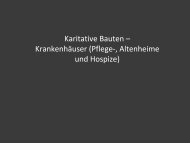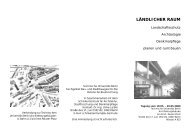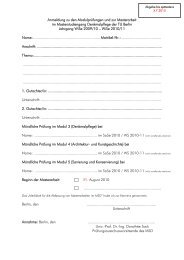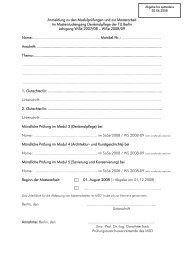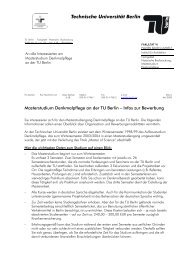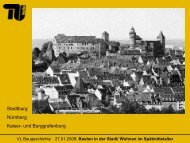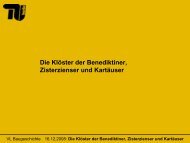Folie 1 - TU Berlin
Folie 1 - TU Berlin
Folie 1 - TU Berlin
Create successful ePaper yourself
Turn your PDF publications into a flip-book with our unique Google optimized e-Paper software.
December 6th, 2009<br />
May 6th, 2011<br />
Qasr al-Mushatta<br />
research and<br />
restoration project<br />
A common effort of<br />
Jordan and Germany<br />
Johannes Cramer, Barbara Perlich Qasr al-Mushatta research and restoration project
The famous desert castles in Jordan – more are available<br />
Johannes Cramer, Barbara Perlich Qasr al-Mushatta research and restoration project
Desert castles:<br />
Qastal and Kharana<br />
Johannes Cramer, Barbara Perlich Qasr al-Mushatta research and restoration project
Desert castles: Kharana<br />
Johannes Cramer, Barbara Perlich Qasr al-Mushatta research and restoration project
Desert castles: Qusair Amra<br />
Johannes Cramer, Barbara Perlich Qasr al-Mushatta research and restoration project
Desert castles: Qusair Amra<br />
Johannes Cramer, Barbara Perlich Qasr al-Mushatta research and restoration project
Desert castles: Qasr al-Tuba<br />
Johannes Cramer, Barbara Perlich Qasr al-Mushatta research and restoration project
Desert castles: Qasr al-Tuba<br />
Johannes Cramer, Barbara Perlich Qasr al-Mushatta research and restoration project
Desert castles: Qasr al-Tuba<br />
Johannes Cramer, Barbara Perlich Qasr al-Mushatta research and restoration project
Desert castle: Qasr al-Mushatta.<br />
The site before 1903 in the<br />
steppe with no human<br />
settlements around<br />
Johannes Cramer, Barbara Perlich Qasr al-Mushatta research and restoration project
The site next to Amman Queen Alia<br />
International Airport from the airplane<br />
threatened by industrial building<br />
activities<br />
Johannes Cramer, Barbara Perlich Qasr al-Mushatta research and restoration project
Qasr al-Mushatta -<br />
shared heritage in Jordan and Germany<br />
Johannes Cramer, Barbara Perlich Qasr al-Mushatta research and restoration project
1. Research strategies<br />
- Evaluation of historic documents<br />
- Surveying<br />
- Documentation<br />
- Archaeology<br />
- Buildings archaeology<br />
- investigation of the surface<br />
- collection of the graffiti<br />
- research in the emerging Islamic art history<br />
Johannes Cramer, Barbara Perlich Qasr al-Mushatta research and restoration project
Now in the new National Museum<br />
More in Kuwait, Jerusalem and<br />
Marocco; some disappeared<br />
Identification of dispersed elements<br />
Johannes Cramer, Barbara Perlich Qasr al-Mushatta research and restoration project
What has been done since 1903:<br />
clearance work<br />
Johannes Cramer, Barbara Perlich Qasr al-Mushatta research and restoration project
aerial archaeology and landscape survey<br />
geodetic survey, mapping of the entire<br />
surfaces<br />
Johannes Cramer, Barbara Perlich Qasr al-Mushatta research and restoration project
exact drawing of the remains: south façade in Jordan<br />
Johannes Cramer, Barbara Perlich Qasr al-Mushatta research and restoration project
exact drawing of the remains: south façade in <strong>Berlin</strong><br />
Johannes Cramer, Barbara Perlich Qasr al-Mushatta research and restoration project
exact drawing of the remains: Detail south façade<br />
Johannes Cramer, Barbara Perlich Qasr al-Mushatta research and restoration project
Johannes Cramer, Barbara Perlich Qasr al-Mushatta research and restoration project
Archaeology in order to<br />
identify the original<br />
ground plan<br />
Yellow: Bujard 2000<br />
Magenta: <strong>TU</strong> <strong>Berlin</strong> 2010<br />
Mosaic tesserae<br />
Johannes Cramer, Barbara Perlich Qasr al-Mushatta research and restoration project
Trench I_03_a.<br />
Foundation East-West.<br />
Looking east; Oct. 2010<br />
Foundations and finds<br />
Axonometric drawing of the foundations in trench I_03_a<br />
Johannes Cramer, Barbara Perlich Qasr al-Mushatta research and restoration project
Excavation in the quarter of the mosque<br />
Foundation of partition wall; Oct.<br />
2010<br />
Trench VIII_08_a.<br />
Looking southwest and<br />
south; Oct. 2010<br />
Johannes Cramer, Barbara Perlich Qasr al-Mushatta research and restoration project
Historic building techniques: brickwork and limestone masonry<br />
Johannes Cramer, Barbara Perlich Qasr al-Mushatta research and restoration project
ickwork: two different<br />
sizes of the bricks<br />
Johannes Cramer, Barbara Perlich Qasr al-Mushatta research and restoration project
lime stone masonry: headers and stretchers<br />
Johannes Cramer, Barbara Perlich Qasr al-Mushatta research and restoration project
Detailed study of the construction<br />
Johannes Cramer, Barbara Perlich Qasr al-Mushatta research and restoration project
High quality surface of the brickwork with one brick<br />
showing an inscription of unknown message<br />
Johannes Cramer, Barbara Perlich Qasr al-Mushatta research and restoration project
Refinement of the limestone masonry:<br />
Embellishment of the joints found<br />
throughout the entire castle<br />
Johannes Cramer, Barbara Perlich Qasr al-Mushatta research and restoration project
Refinement of the brickwork:<br />
Numerous remains of plaster<br />
Johannes Cramer, Barbara Perlich Qasr al-Mushatta research and restoration project
Refinement of<br />
the walls and<br />
flooring:<br />
colourful mosaic<br />
tesserae<br />
Johannes Cramer, Barbara Perlich Qasr al-Mushatta research and restoration project
Refinement of the flooring: big green<br />
marble slabs<br />
Johannes Cramer, Barbara Perlich Qasr al-Mushatta research and restoration project
Refinement of the decoration: red colour in the rosettas of the palace<br />
Johannes Cramer, Barbara Perlich Qasr al-Mushatta research and restoration project
Numerous fragments of<br />
sculpture in the palace<br />
Johannes Cramer, Barbara Perlich Qasr al-Mushatta research and restoration project
Results of the research project<br />
- Complete documentation of the actual situation of the ruin<br />
- Archaeological evidence concerning ground plan<br />
- The palace did not remain a ruin but was finished and used<br />
in the central area<br />
- Reconsidering the dating of Mushatta<br />
Foundations<br />
finished<br />
Definitely<br />
completely<br />
finished<br />
Eventually<br />
finished<br />
Johannes Cramer, Barbara Perlich Qasr al-Mushatta research and restoration project<br />
Only<br />
trenches<br />
of foundations<br />
finished
Excavation in the central court of the castle<br />
Johannes Cramer, Barbara Perlich Qasr al-Mushatta research and restoration project
Location of the excavation<br />
Johannes Cramer, Barbara Perlich Qasr al-Mushatta research and restoration project
Earthquake has thrown down the arches<br />
of the facade and twisted the pillars<br />
Johannes Cramer, Barbara Perlich Qasr al-Mushatta research and restoration project
Coin of around 760<br />
under the pavement of<br />
the court and under the<br />
stones of the arches<br />
Johannes Cramer, Barbara Perlich Qasr al-Mushatta research and restoration project
2. Restoration strategies<br />
- Safeguarding the existing fabric by conservation<br />
- Stop further loss of precious works of art<br />
- Improve the understanding of the ruin for visitors by<br />
° Rebuilding the facade of the palace<br />
° Rebuilding the inner arch of the audience hall<br />
° Closing the gap of the main gate<br />
° Site management and visitor center<br />
Johannes Cramer, Barbara Perlich Qasr al-Mushatta research and restoration project
Current restoration project:<br />
repair of the old brickwork in the elevation with old bricks<br />
Johannes Cramer, Barbara Perlich Qasr al-Mushatta research and restoration project
Mortar is produced from lime,<br />
sand, crushed bricks, a bit of<br />
clay and with lots of ashes –<br />
the use of cement in a<br />
historic monument is a<br />
crime against heritage<br />
Johannes Cramer, Barbara Perlich Qasr al-Mushatta research and restoration project
Current restoration project:<br />
repair of the brickwork in the wall tops with new bricks<br />
Johannes Cramer, Barbara Perlich Qasr al-Mushatta research and restoration project
How to produce<br />
new bricks:<br />
First study the<br />
old ones: brick<br />
with special<br />
traces; bricks<br />
with stamp –<br />
unique find<br />
Johannes Cramer, Barbara Perlich Qasr al-Mushatta research and restoration project
Brick production is not easy: numerous ingredients like clay, sand, straw<br />
Johannes Cramer, Barbara Perlich Qasr al-Mushatta research and restoration project
Brick production: forming the adobes<br />
Johannes Cramer, Barbara Perlich Qasr al-Mushatta research and restoration project
Brick production: filling the kiln<br />
Johannes Cramer, Barbara Perlich Qasr al-Mushatta research and restoration project
Brick production in a very traditional way:<br />
Kiln before firing bricks for two full days,<br />
after this the kiln will cool down for<br />
another 10 days – slow production.<br />
100.000 bricks needed 18 months.<br />
Johannes Cramer, Barbara Perlich Qasr al-Mushatta research and restoration project
Selection of old bricks – numerous different colors<br />
Johannes Cramer, Barbara Perlich Qasr al-Mushatta research and restoration project
Old and new brick – color is similar<br />
Johannes Cramer, Barbara Perlich Qasr al-Mushatta research and restoration project
Old bricks inside, new<br />
bricks on the surface as<br />
sacrifice layer<br />
Johannes Cramer, Barbara Perlich Qasr al-Mushatta research and restoration project
Current restoration project: repair of the brickwork – results achieved<br />
Johannes Cramer, Barbara Perlich Qasr al-Mushatta research and restoration project
Future Project 1: raising<br />
the western elevation in order<br />
to obscure the ugly industrial<br />
zone<br />
Johannes Cramer, Barbara Perlich Qasr al-Mushatta research and restoration project
Hedjaz railway track<br />
Mushatta is threatened<br />
by a growing industrial<br />
zone approaching the<br />
ruin – the visual integrity<br />
is highly endangered<br />
Air cargo access<br />
to the airport<br />
Johannes Cramer, Barbara Perlich Qasr al-Mushatta research and restoration project
Environmental aspects 1: Plants and flowers<br />
Johannes Cramer, Barbara Perlich Qasr al-Mushatta research and restoration project
Environmental aspects 2:<br />
Animals - various birds and lizzards<br />
falcon<br />
Johannes Cramer, Barbara Perlich Qasr al-Mushatta research and restoration project
Current restoration project: Anastylosis of the facade of the palace<br />
Johannes Cramer, Barbara Perlich Qasr al-Mushatta research and restoration project
location of various<br />
line drawings<br />
Johannes Cramer, Barbara Perlich Qasr al-Mushatta research and restoration project
Line drawings –<br />
sketch of the<br />
arcade, not to scale<br />
Johannes Cramer, Barbara Perlich Qasr al-Mushatta research and restoration project
econstruction of the colonnaded court,<br />
superimposed with the line drawings<br />
Johannes Cramer, Barbara Perlich Qasr al-Mushatta research and restoration project
lime stone masonry: headers and stretchers<br />
Johannes Cramer, Barbara Perlich Qasr al-Mushatta research and restoration project
line drawing for a decoration inside the palace, scale 1:1<br />
Johannes Cramer, Barbara Perlich Qasr al-Mushatta research and restoration project
line drawing of a design for a decoration, scale 1:1,<br />
superimposed on the south façade<br />
Johannes Cramer, Barbara Perlich Qasr al-Mushatta research and restoration project
line drawing of an arch, scale 1:1<br />
Johannes Cramer, Barbara Perlich Qasr al-Mushatta research and restoration project
line drawing, scale 1:1, superimposed on the three-arched façade<br />
Johannes Cramer, Barbara Perlich Qasr al-Mushatta research and restoration project
layout superimposed on the realized reconstruction<br />
Johannes Cramer, Barbara Perlich Qasr al-Mushatta research and restoration project
Detailed planning for the scaffolding<br />
Johannes Cramer, Barbara Perlich Qasr al-Mushatta research and restoration project
Reinforced brickwork<br />
Johannes Cramer, Barbara Perlich Qasr al-Mushatta research and restoration project
Sophisticated technology<br />
inside the brickwork:<br />
reinforcement against<br />
earthquake challenges<br />
Johannes Cramer, Barbara Perlich Qasr al-Mushatta research and restoration project
Rosetta reassembled from<br />
five different fragments<br />
Johannes Cramer, Barbara Perlich Qasr al-Mushatta research and restoration project
Rosettas reassembled<br />
Johannes Cramer, Barbara Perlich Qasr al-Mushatta research and restoration project
New stones are brilliant<br />
white as the old ones have<br />
been more than thousand<br />
years ago. New stone glued<br />
to an old one.<br />
New stones for the arches<br />
Johannes Cramer, Barbara Perlich Qasr al-Mushatta research and restoration project
Continuous use of traditional<br />
techniques: liquid mortar<br />
filled into the masonry –<br />
channels prepared for fill-in<br />
in the stones for the arches<br />
Johannes Cramer, Barbara Perlich Qasr al-Mushatta research and restoration project
Future Project 1: Rebuilding the inner arch of the reception hall<br />
Johannes Cramer, Barbara Perlich Qasr al-Mushatta research and restoration project
Stones of the arch of the audience hall<br />
Johannes Cramer, Barbara Perlich Qasr al-Mushatta research and restoration project
Stones are reduced and<br />
looted in various ways<br />
Johannes Cramer, Barbara Perlich Qasr al-Mushatta research and restoration project
Unfinished decoration of<br />
the inner arch of the<br />
audience hall<br />
Johannes Cramer, Barbara Perlich Qasr al-Mushatta research and restoration project
Rebuilding the arch of<br />
the audience hall<br />
Johannes Cramer, Barbara Perlich Qasr al-Mushatta research and restoration project
Future Project 3: Closing the gap of the main gate. Situation as today<br />
and in 1903 before dismanteling the western wing for transport to Germany<br />
Johannes Cramer, Barbara Perlich Qasr al-Mushatta research and restoration project
Present situation after anastylosis of the palace façade<br />
Johannes Cramer, Barbara Perlich Qasr al-Mushatta research and restoration project
Solution 2: volume of the 1903 situation<br />
rebuilt in solid limestone masonry with<br />
abstracted decoration including original<br />
elements still found on the site<br />
Johannes Cramer, Barbara Perlich Qasr al-Mushatta research and restoration project
Solution 3: augmented reality as app for smartphone<br />
current situation superimposed with photograph of before 1903<br />
Johannes Cramer, Barbara Perlich Qasr al-Mushatta research and restoration project
Thank you for your attention<br />
Thanks to everybody who supported the project, namely the<br />
Department of Antiquities of Jordan, and the entire staff of Jordan,<br />
Germany, <strong>Berlin</strong> National Museums and <strong>Berlin</strong> Institute of<br />
Technology together with those who provided the financial means:<br />
German Research Foundation and German Foreign Office<br />
Johannes Cramer, Barbara Perlich Qasr al-Mushatta research and restoration project
Bauwerke zum Thema, die man<br />
gesehen haben sollte (5)<br />
Fachhochschule Wildau<br />
Anderhalten Architekten<br />
War: Lokomotivenfabrik<br />
Ist: Hochschulgebäude<br />
Johannes Cramer, Barbara Perlich Qasr al-Mushatta research and restoration project



